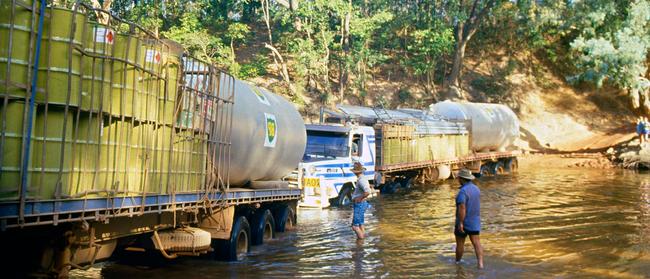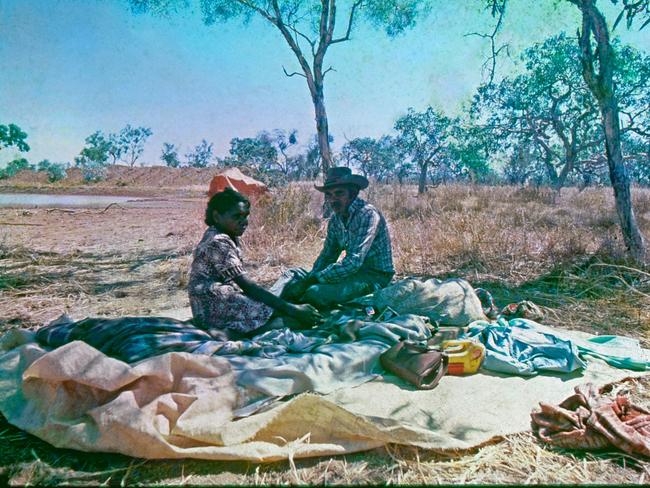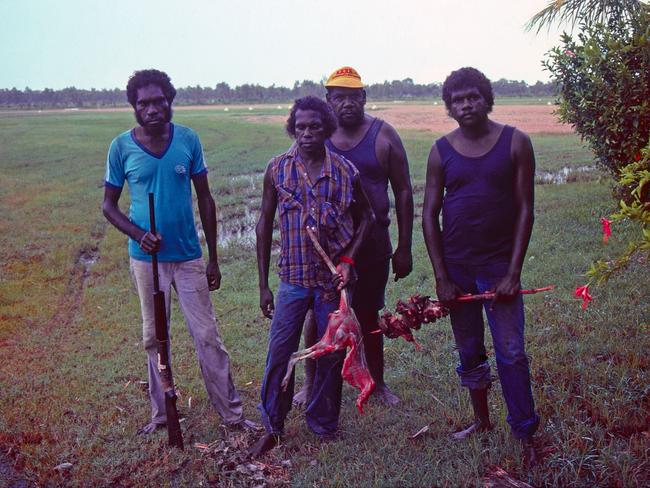Ando’s Talk of the North: A glimpse of the northwest, gulf and Cape York in the 1980s
In his latest Talk of the North, Ando stumbles across old boxes of photos he took in the northwest, Gulf region and Cape York Peninsula during the 1980s.
News
Don't miss out on the headlines from News. Followed categories will be added to My News.
A SHED clean-out is something that happens rarely at chez Andersen, but when it does it can be a brutal, full-on shock and awe confrontation. Really, does anyone actually need five cast iron frying pans, three woks, six grills and steel barbecue plates in the shed? These things come into your possession and you can’t bear to throw them out. “That’ll be handy,” you think.
This time I came across boxes of slides and negatives with proof sheets attached, most of them photos I took in the northwest and Gulf region and Cape York Peninsula in the 1980s.
They have not been looked after as they should have been and show signs of wear and tear, but still, they show how life was just that little bit different 40 years ago.
Michael Petersen at the Herberton Spy Camera Museum did a good job of bringing some of them back to life. I’ve added a brief description of what each photo is about.
MALCOLM HUSSAN’S HUT
This hut built by bush recluse Malcolm Hussan was hidden behind the sand dunes on the Gulf of Carpentaria coast between Cliffdale Creek and Westmoreland Station.
It was where Hussan, who was of Aboriginal and Afghani descent, spent the wet seasons. He hunted with a spear and a single shot .22 rifle. He would roam far and wide and it was nothing to see him up on a ridge line on Lawn Hill Station way to the south.
I met Malcolm at Cliffdale Station when it was owned by Bill and Lee Olive and later came across his hut when camped at Cliffdale Creek on the Gulf coast.
Made from paperbark and ti-tree saplings, it was a masterpiece in design.
Only a handful of people knew where it was located. But vandals found it. The deadbeats in this case were said to be fishermen who came in by boat. They burnt it to the ground.
What gratification they achieved from this, only they would know. Malcolm died in hospital in Mount Isa not long after.
He was estimated to be 56 years old and had only ever been to Burketown, Doomadgee, Camooweal and Cloncurry.
It was his first trip to Mount Isa and it was the first time he had slept in a bed with white sheets. It was the furthest south he had ever been.
His normal bed was a blanket in a swag. He died in that Mt Isa hospital bed with its white sheets and not out in the bush or in his hut where he was truly at home.

MYERS TRUCKS
This is a photo of the Myers Brothers trucks crossing Cape York Peninsula’s Wenlock River in 1986. Myers Brothers transported bulk fuel to Bamaga and other remote communities such as Pormpuraaw, Lockhart River, Kowanyama and Coen.
The trucks had to leave the main Peninsula track after crossing the Wenlock and drive on station tracks through Bramwell Station and Heathlands, skirting around the headwaters of westward flowing rivers and creeks, before swinging back west to come out on the southern side of the Jardine River.
I was a member of a party accompanying the trucks on this particular trip. Therese Heinemann, who then owned Bramwell, met us outside the homestead, blocking the party’s progress. It wasn’t so much Mrs Heinemann who caused the party to a draw to a stop, but the lever action Winchester rifle she held crosswise across her chest.
One member of the party walked towards her with two 40oz bottles of Bundaberg Rum, which she accepted before stepping aside and letting the convoy through. Transport companies like Myers Brothers did so much to help people living beyond the frontier have access to the basic necessities such as fuel and building supplies.
GARY GOULD
Gary Gould in his bull catching camp on Westmoreland Station. The station is on the Northern Territory border in Queensland’s western Gulf Country. The 4WDs were used to chase wild, cleanskin bulls which roamed the property. The animals would be nudged over with the bulbar and their back legs tied.
Once secured, a rope would be looped around their horns and they would be tied to a tree for a pick-up by truck. On some occasions if the trees were too thick or the ground too rocky, the animals might manage to stay just ahead of the pursuing vehicle. When this happened, they would be chased down on foot and thrown by the tail and then secured.

REX AND MAGGIE
Westmoreland Station workers Rex Shadforth and his wife Maggie resting on the swag in the bull catching camp on the station. This was not long after a scrub bull horned rex in the groin, tearing open his scrotum and exposing his testicles.
The Royal Flying Doctor Service in Mount Isa advised Fran Gould over the radio that it was not serious and prescribed a treatment. Fran went back, had another look and again rang the flying doctor and said it was too serious and she needed help. The flying doctor again said it was not that serious and gave Fran instructions on how to treat the wound. She did what she was told and the wound healed.
Rex later laughed while having a beer in the Burketown pub, saying “it didn’t stop me and Maggie one little bit”.
TOOTS THE TRUCKIE
Toots Holzheimer was no fashion plate, but she blazed a trail for women truck drivers to follow. Toots carted freight from Cairns to Weipa and from Cairns to Kowanyama on the western Gulf.
She was no-frills and never wanted any help when doing running repairs on her truck. On this occasion when the photo was taken, she had a flat tyre and refused all my offers to give her a hand. She slept in the truck when on the road and was universally regarded as ‘a good scout’. Toots was tragically killed on the Weipa wharf in 1992 while unloading her truck.
SEBASTIAO MAIA
Sebastiao Maia, a Brazilian billionaire, bought a string of North Queensland properties including Lawn Hill Station in the late 1970s. He was a colourful figure who would fly Las Vegas showgirls to Lawn Hill for party time.
He died in the late 1990s but owned meatworks and ranches in Brazil, cold stores and haulage companies. His extensive land purchases in North West Queensland were only given the green light when the cagey Mr Maia announced he was planning on building a meatworks at Julia Creek. Consultants he hired told him that the unions would not tolerate a Brazilian-owned meatworks in Australia.
This is now ironic in a way because JBS, which owns extensive abattoir holdings in Australia including the Stuart meatworks in Townsville, is a subsidiary of JBS Brazil. The consultants also said Julia Creek was too remote and that cattle numbers in the region did not justify a meatworks. These last two points are still obstacles that have to be overcome when it comes to developing meat processing plants in inland North Queensland.
One of the girls from Las Vegas cleared out with one of the station ringers on the back of a motorbike. Presumably they were headed for a new life in Mt Isa, 400km to the south.

CAPE YORK HUNTERS
Hunters return with their dinner at Pormpuraaw (Edward River) Western Cape York Peninsula. Wild game was plentiful. Wallabies, goannas, pigs and feral cattle were shot or speared for food in the bush. And in the ocean, creeks and rivers, fish and crabs were there for the taking. The meat was usually cooked on fires that were always smouldering in front yards.
JOKE TIME
I went to a Chinese restaurant last night and got talking to the waiter who told me he was living in Japan at the start of WW II. He was drafted into the air force and became a kamikaze pilot with the code name, Chow Mein. I politely said, “but if you were a kamikaze, weren’t you supposed to sacrifice your own life? Ah, he said, you very astute, but my full name be Chicken Chow Mein”.
Originally published as Ando’s Talk of the North: A glimpse of the northwest, gulf and Cape York in the 1980s


